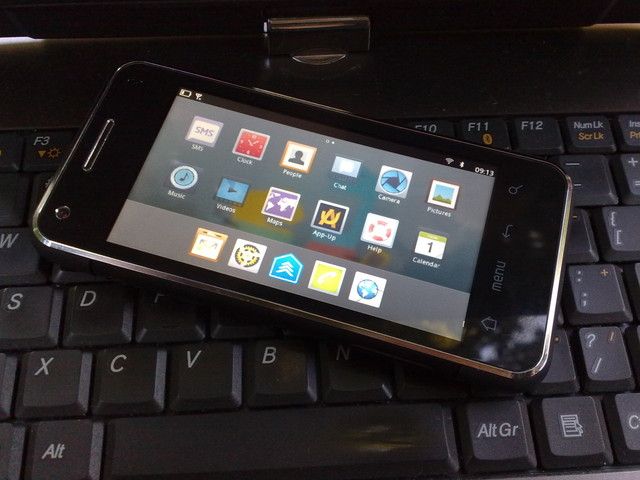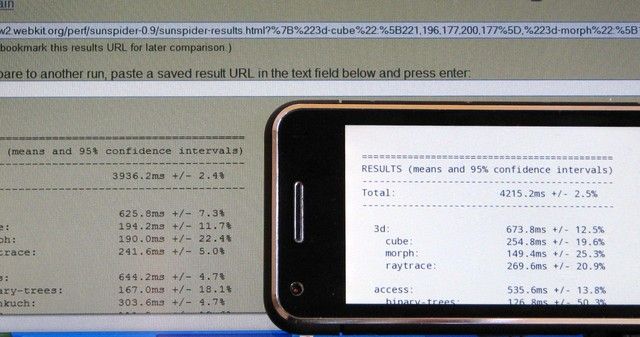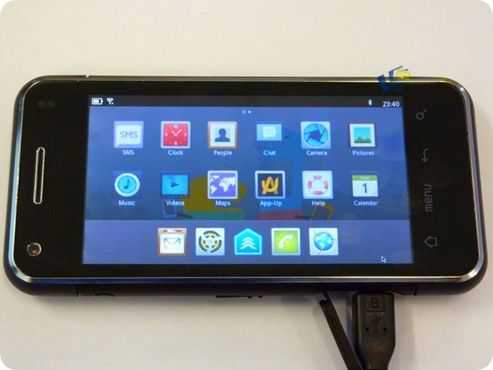I hope you’ve already read the ‘warning’ article I posted last week because unfortunately, the Aava phone isn’t something we can review or draw any conclusions from. It’s a developer platform, a demonstrator and a showcase item. It’s using beta hardware and pre-Alpha software too so if you’re expecting something shiny at this stage, I’m sorry that this article will probably disappoint you. If you see others drawing conclusions based on their (or this) hands-on, you should also treat them as inconclusive. It’s just too early to tell.
At best, I can highlight the platform for potential ISVs, OEMs, competitors, integrators, carriers and Linux distributors and maybe mention something about the direction of the handheld UX (user experience) for MeeGo but both hardware and software are likely to change drastically before launch in Q4. It would be great for our traffic and links if we were to trumpet a breakthrough in processing power and UI but I’m sorry, you’re going have to wait until we see real products before that happens. I know, I’ll never be a real journalist ;-)
I want to thank Intel Europe before going any further though. (You can follow their Atom-related work on Twitter) They’ve been open about their work with the platform and respect to them for giving early-stage prototypes out to a blogger. There’s always a big risk in doing that. We remain in good contact with the Intel teams and will do further testing in due course.
So on to the ‘product’ then. Using the Intel Moorestown platform, the Aava phone at least highlights how small a ‘PC’ can be. It’s a truly pocketable size and comes with all that you would expect from a smartphone; Capacitive screen, camera, stereo speakers, Micro-SD and Micro USB and a 5.5Wh battery. We would have liked to have got into the command-line to check out some more hardware and battery usage information but in the limited time we had, it wasn’t possible. What we did do though was check out the pre-Alpha (developers) build of MeeGo 1.1 It’s the first time we’ve been able to touch the UI and to get an idea of the look and feel and although it doesn’t bring anything dramatically new in terms of layout, it builds on intuitive swipes and taps to make a UI that was simple to understand. A home-screen where presumably you’ll find widgets, presents a small launcher bar for some favorite apps and the application list itself. This second-layer application pane is similar to Android and forces the user, in many cases, to have to unlock, open the application pane, find the application and then launch it which is one layer of UI deeper than you’ll find on the iPhone. It makes way for an active homescreen though. We weren’t able to experience notifications on this version of MeeGo.

Full Aava / MeeGo gallery available here.
Not much is working on this build and most applications are placeholders but we got to check out the dialer application (phone stack didn’t appear to be functional), some settings (WiFi was working) and the Firefox Mobile browser which has potential to be a very high quality browser if startup and page view times can be improved. The recent build for Maemo includes some really advanced features which weren’t working on this MeeGo build.
There was one test we were able to do and that was the popular Javascript processing test Sunspider. With careful consideration of browser software, it’s possible to get a feel for the CPU processing power available and the results were quite amazing. In comparison with an Android 1.6 phone running a 1Ghz Snapdragon platform we were seeing results 5x as fast and indicative of a netbook processor rather than a current ARM-core smartphone processor. It makes sense of course as the phone is, in theory, running Atom at up to 1.5Ghz. There’s clearly potential for some good multitasking. There’s also potential to drain that battery faster than on any ARM-based smartphone. It’s a case of being able to get things done quickly if the OS and user is well controlled and this is something that the MeeGo developers will have to think carefully about. Should they turn off the ‘Turbo’ features if the battery reaches a certain level? Should applications be throttled or scheduled when the device is locked perhaps?
You’ll see all the details in the video below and this additional article about the Javascript test but there’s one more thing we can gleen from our time with the device and that’s timescales for products. MeeGo is in very early stage development and it wouldn’t be wildly wrong to estimate that it won’t be ready for another year or more especially considering the amount of catch-up that the platform is having to do. The App-store will need to be loaded too and that will take money, and time. MeeGo 1.1 will be released in October but that doesn’t mean that products will be ready. In October, the core and UI will be ready for 3rd parties to finalise into their own products which means internal testing, field testing, approval and certification can only be started once the final builds are incorporated into whatever variants OEMs are working on. The first smartphone products won’t be out of the door in 2010 although we might see some non-3G tablets and MIDs reach the some markets for Christmas if they don’t have to go through GSM/UMTS approval. For a mature and complete MeeGo-based phone product, we need to look to Q2 2011 in my opinion. Nokia, given their existing Maemo application base and developer-focused N900 community, are in a good position to be one of the first.


















